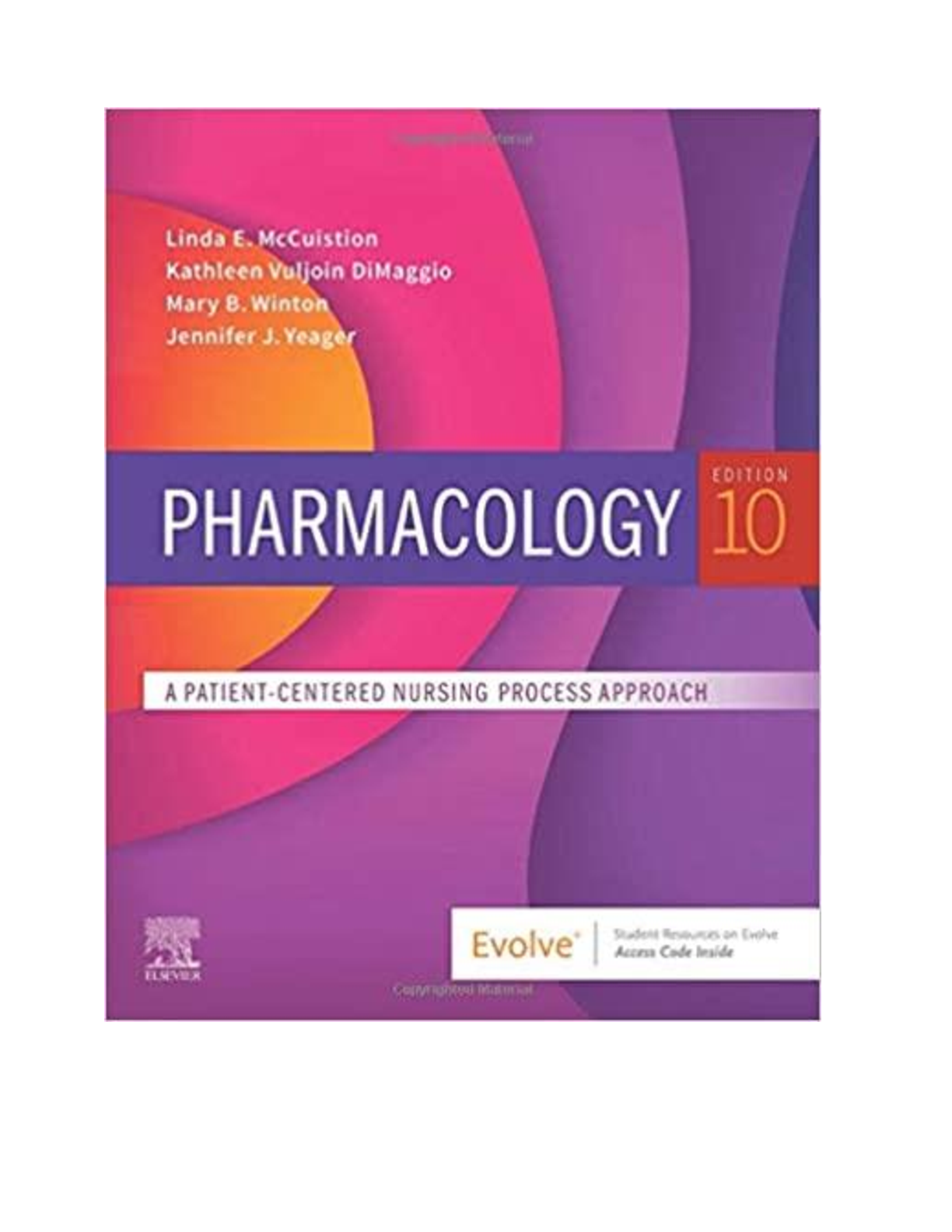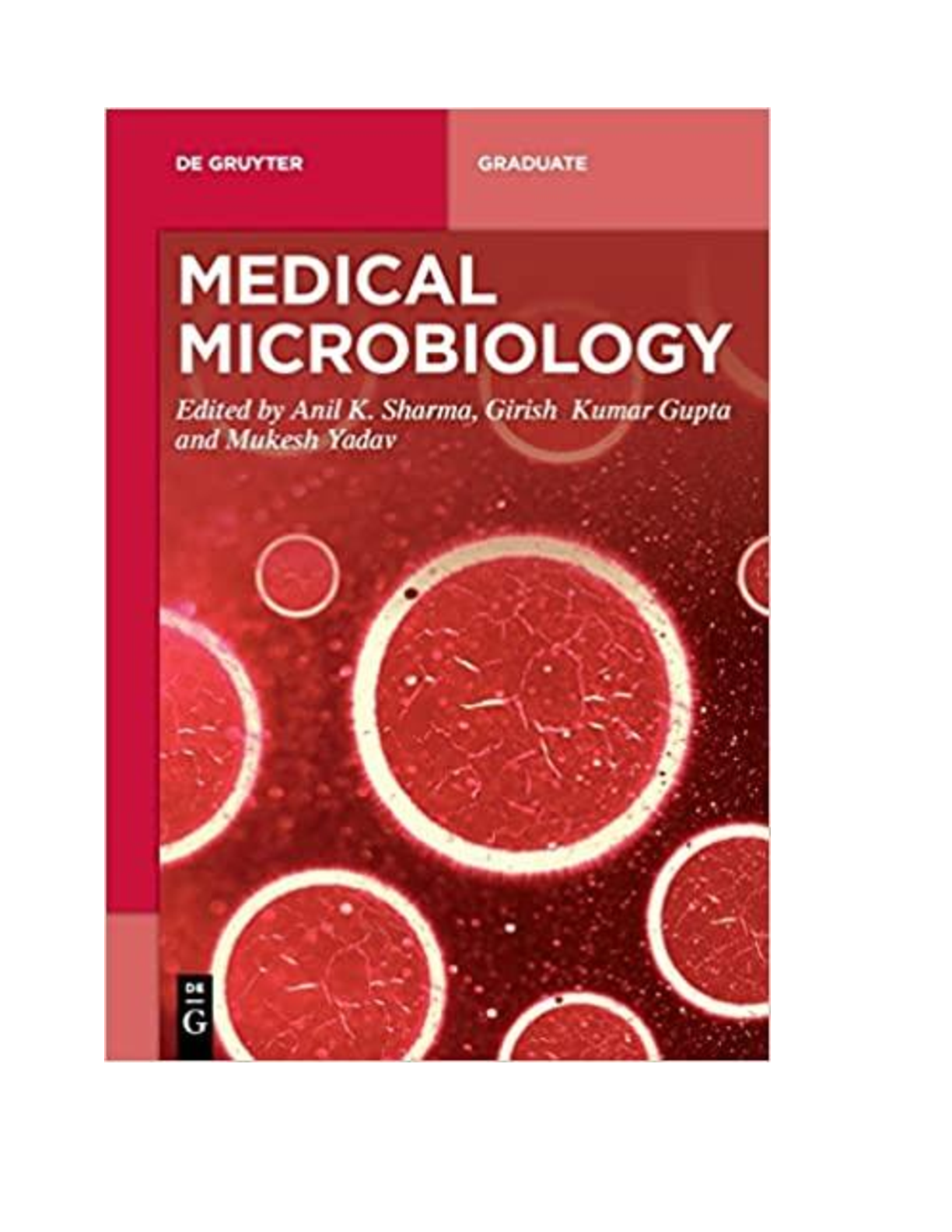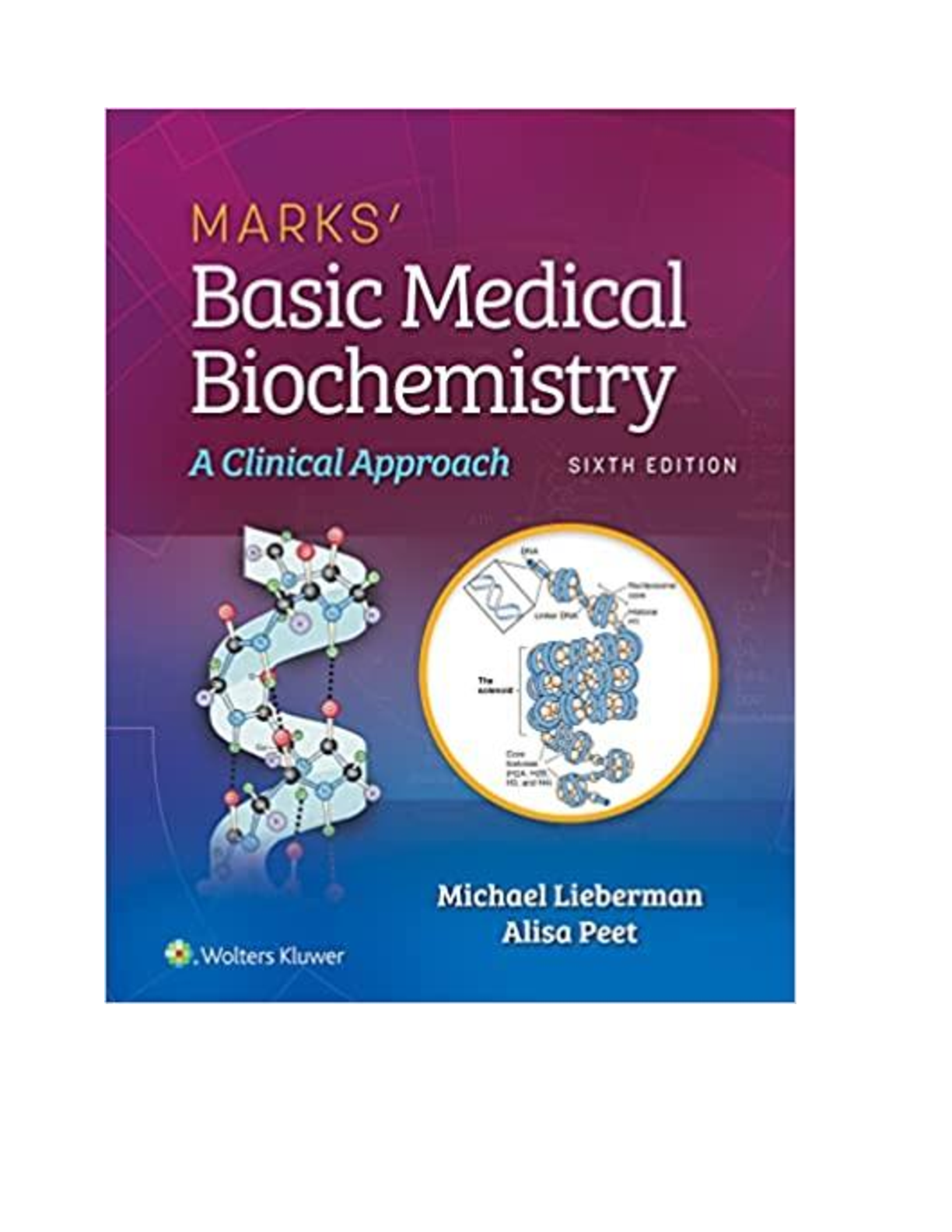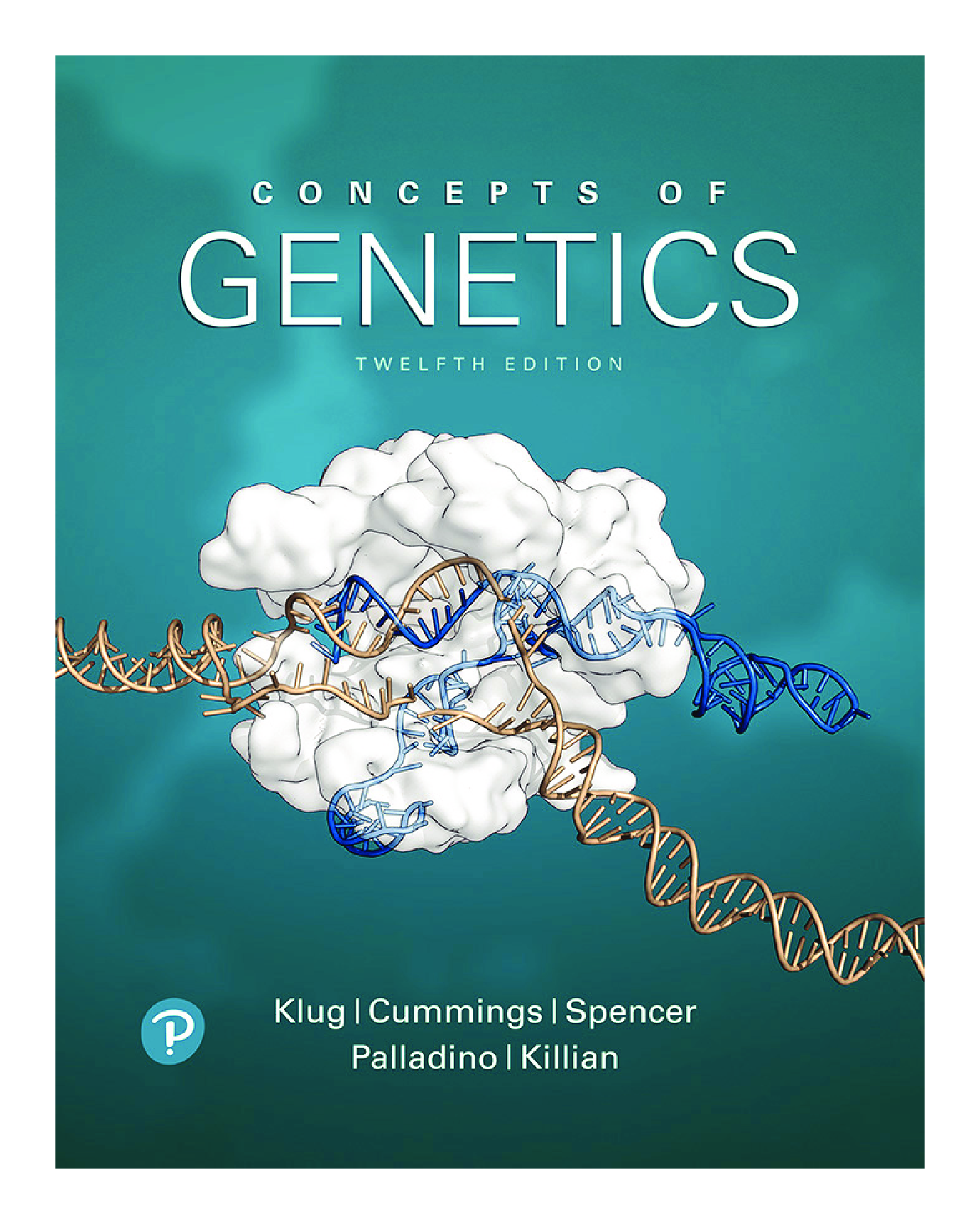Medical Studies > eBook-PDF > Essentials of Genetics, 10th edition By William S Klug, Michael Cummings, Charlotte A. Spencer, Mich (All)
Essentials of Genetics, 10th edition By William S Klug, Michael Cummings, Charlotte A. Spencer, Michael A Palladino, Darrell Killian (eBook PDF)
Document Content and Description Below
Title Page Copyright Page About the Authors Contents Chapter 1: Introduction to Genetics 1.1 Genetics Has an Interesting Early History 1.2 Genetics Progressed from Mendel to DNA in Less Than a C... entury 1.3 Discovery of the Double Helix Launched the Era of Molecular Genetics 1.4 Development of Recombinant DNA Technology Began the Era of DNA Cloning 1.5 The Impact of Biotechnology Is Continually Expanding 1.6 Genomics, Proteomics, and Bioinformatics Are New and Expanding Fields 1.7 Genetic Studies Rely on the Use of Model Organisms 1.8 Genetics Has Had a Profound Impact on Society Problems and Discussion Questions Chapter 2: Mitosis and Meiosis 2.1 Cell Structure Is Closely Tied to Genetic Function 2.2 Chromosomes Exist in Homologous Pairs in Diploid Organisms 2.3 Mitosis Partitions Chromosomes into Dividing Cells 2.4 Meiosis Creates Haploid Gametes and Spores and Enhances Genetic Variation in Species 2.5 The Development of Gametes Varies in Spermatogenesis Compared to Oogenesis 2.6 Meiosis Is Critical to Sexual Reproduction in All Diploid Organisms 2.7 Electron Microscopy Has Revealed the Physical Structure of Mitotic and Meiotic Chromosomes EXPLORING GENOMICS: PubMed: Exploring and Retrieving Biomedical Literature CASE STUDY: Timing is everything Insights and Solutions Problems and Discussion Questions Chapter 3: Mendelian Genetics 3.1 Mendel Used a Model Experimental Approach to Study Patterns of Inheritance 3.2 The Monohybrid Cross Reveals How One Trait Is Transmitted from Generation to Generation 3.3 Mendel’s Dihybrid Cross Generated a Unique Ratio 3.4 The Trihybrid Cross Demonstrates That Mendel’s Principles Apply to Inheritance of Multiple Tra 3.5 Mendel’s Work Was Rediscovered in the EarlyTwentieth Century EVOLVING CONCEPT OF THE GENE 3.6 Independent Assortment Leads to Extensive Genetic Variation 3.7 Laws of Probability Help to Explain Genetic Events 3.8 Chi‐Square Analysis Evaluates the Influence of Chance on Genetic Data 3.9 Pedigrees Reveal Patterns of Inheritance of Human Traits 3.10 Tay–Sachs Disease: The Molecular Basis of a Recessive Disorder in Humans EXPLORING GENOMICS: Online Mendelian Inheritance in Man CASE STUDY: To test or not to test Insights and Solutions Problems and Discussion Questions Chapter 4: Modification of Mendelian Ratios 4.1 Alleles Alter Phenotypes in Different Ways 4.2 Geneticists Use a Variety of Symbols for Alleles 4.3 Neither Allele Is Dominant in Incomplete, or Partial, Dominance 4.4 In Codominance, the Influence of Both Alleles in a Heterozygote Is Clearly Evident 4.5 Multiple Alleles of a Gene May Exist in a Population 4.6 Lethal Alleles Represent Essential Genes EVOLVING CONCEPT OF THE GENE 4.7 Combinations of Two Gene Pairs with Two Modes of Inheritance Modify the 9:3:3:1 Ratio 4.8 Phenotypes Are Often Affected by More Than One Gene 4.9 Complementation Analysis Can Determine if Two Mutations Causing a Similar Phenotype Are Alleles 4.10 Expression of a Single Gene May Have Multiple Effects 4.11 X‐Linkage Describes Genes on the X Chromosome 4.12 In Sex‐Limited and Sex‐Influenced Inheritance, an Individual’s Gender Influences the Phen 4.13 Genetic Background and the Environment Affect Phenotypic Expression 4.14 Extranuclear Inheritance Modifies Mendelian Patterns GENETICS, ETHICS, AND SOCIETY: Mitochondrial Replacement and Three‐Parent Babies CASE STUDY: Is it all in the genes? Insights and Solutions Problems and Discussion Questions Chapter 5: Sex Determination and Sex Chromosomes 5.1 X and Y Chromosomes Were First Linked to Sex Determination Early in the Twentieth Century 5.2 The Y Chromosome Determines Maleness in Humans 5.3 The Ratio of Males to Females in Humans Is Not 1.0 5.4 Dosage Compensation Prevents Excessive Expression of X‐Linked Genes in Humans and Other Mammal 5.5 The Ratio of X Chromosomes to Sets of Autosomes Can Determine Sex 5.6 Temperature Variation Controls Sex Determination in Reptiles GENETICS, ETHICS, AND SOCIETY: A Question of Gender: Sex Selection in Humans CASE STUDY: Is the baby a boy or a girl? Insights and Solutions Problems and Discussion Questions Chapter 6: Chromosome Mutations: Variation in Number and Arrangement 6.1 Variation in Chromosome Number: Terminology and Origin 6.2 Monosomy and Trisomy Result in a Variety of Phenotypic Effects 6.3 Polyploidy, in Which More Than Two Haploid Sets of Chromosomes Are Present, Is Prevalent in Plan 6.4 Variation Occurs in the Composition and Arrangement of Chromosomes 6.5 A Deletion Is a Missing Region of a Chromosome 6.6 A Duplication Is a Repeated Segment of a Chromosome 6.7 Inversions Rearrange the Linear Gene Sequence 6.8 Translocations Alter the Location of Chromosomal Segments in the Genome 6.9 Fragile Sites in Human Chromosomes Are Susceptible to Breakage GENETICS, ETHICS, AND SOCIETY: Down Syndrome and Prenatal Testing—The New Eugenics? CASE STUDY: Fish tales Insights and Solutions Problems and Discussion Questions Chapter 7: Linkage and Chromosome Mapping in Eukaryotes 7.1 Genes Linked on the Same Chromosome Segregate Together 7.2 Crossing Over Serves as the Basis of Determining the Distance between Genes during Mapping 7.3 Determining the Gene Sequence during Mapping Requires the Analysis of Multiple Crossovers 7.4 As the Distance between Two Genes Increases, Mapping Estimates Become More Inaccurate EVOLVING CONCEPT OF THE GENE 7.5 Chromosome Mapping Is Now Possible Using DNA Markers and Annotated Computer Databases 7.6 Other Aspects of Genetic Exchange EXPLORING GENOMICS: Human Chromosome Maps on the Internet CASE STUDY: Links to autism Insights and Solutions Problems and Discussion Questions Chapter 8: Genetic Analysis and Mapping in Bacteria and Bacteriophages 8.1 Bacteria Mutate Spontaneously and Are Easily Cultured 8.2 Genetic Recombination Occurs in Bacteria 8.3 The F Factor Is an Example of a Plasmid 8.4 Transformation Is Another Process Leading to Genetic Recombination in Bacteria 8.5 Bacteriophages Are Bacterial Viruses 8.6 Transduction Is Virus‐Mediated Bacterial DNA Transfer GENETICS, ETHICS, AND SOCIETY: Multidrug‐Resistant Bacteria: Fighting with Phage CASE STUDY: To test or not to test Insights and Solutions Problems and Discussion Questions Chapter 9: DNA Structure and Analysis 9.1 The Genetic Material Must Exhibit Four Characteristics 9.2 Until 1944, Observations Favored Protein as the Genetic Material 9.3 Evidence Favoring DNA as the Genetic Material Was First Obtained during the Study of Bacteria an 9.4 Indirect and Direct Evidence Supports the ConceptThat DNA Is the Genetic Material in Eukaryotes 9.5 RNA Serves as the Genetic Material in Some Viruses 9.6 The Structure of DNA Holds the Key to Understanding Its Function EVOLVING CONCEPT OF THE GENE 9.7 Alternative Forms of DNA Exist 9.8 The Structure of RNA Is Chemically Similar to DNA, but Single Stranded 9.9 Many Analytical Techniques Have Been Useful during the Investigation of DNA and RNA EXPLORING GENOMICS: Introduction to Bioinformatics: Blast CASE STUDY: Credit where credit is due Insights and Solutions Problems and Discussion Questions Chapter 10: DNA Replication 10.1 DNA Is Reproduced by Semiconservative Replication 10.2 DNA Synthesis in Bacteria Involves Five Polymerases, as Well as Other Enzymes 10.3 Many Complex Issues Must Be Resolved during DNA Replication 10.4 A Coherent Model Summarizes DNA Replication 10.5 Replication Is Controlled by a Variety of Genes 10.6 Eukaryotic DNA Replication Is Similar to Replication in Bacteria, but Is More Complex 10.7 Telomeres Solve Stability and Replication Problemsat Eukaryotic Chromosome Ends GENETICS, ETHICS, AND SOCIETY: Telomeres: The Key to a Long Life? CASE STUDY: At loose ends Insights and Solutions Problems and Discussion Questions Chapter 11: Chromosome Structure and DNA Sequence Organization 11.1 Viral and Bacterial Chromosomes Are Relatively Simple DNA Molecules 11.2 Mitochondria and Chloroplasts Contain DNA Similar to Bacteria and Viruses 11.3 Specialized Chromosomes Reveal Variations in the Organization of DNA 11.4 DNA Is Organized into Chromatin in Eukaryotes 11.5 Eukaryotic Genomes Demonstrate Complex Sequence Organization Characterized by Repetitive DNA 11.6 The Vast Majority of a Eukaryotic Genome Does Not Encode Functional Genes EXPLORING GENOMICS: Database of Genomic Variants: Structural Variations in the Human Genome CASE STUDY: Helping or hurting? Insights and Solutions Problems and Discussion Questions Chapter 12: The Genetic Code and Transcription 12.1 The Genetic Code Exhibits a Number of Characteristics 12.2 Early Studies Established the Basic Operational Patterns of the Code 12.3 Studies by Nirenberg, Matthaei, and Others Deciphered the Code 12.4 The Coding Dictionary Reveals the Function of the 64 Triplets 12.5 The Genetic Code Has Been Confirmed in Studies of Bacteriophage MS2 12.6 The Genetic Code Is Nearly Universal 12.7 Different Initiation Points Create Overlapping Genes 12.8 Transcription Synthesizes RNA on a DNA Template 12.9 RNA Polymerase Directs RNA Synthesis 12.10 Transcription in Eukaryotes Differs from Bacterial Transcription in Several Ways 12.11 The Coding Regions of Eukaryotic Genes Are Interrupted by Intervening Sequences Called Introns EVOLVING CONCEPT OF THE GENE 12.12 RNA Editing May Modify the Final Transcript 12.13 Transcription Has Been Visualized by Electron Microscopy CASE STUDY: Treatment dilemmas GENETICS, ETHICS, AND SOCIETY: Treating Duchenne Muscular Dystrophy with Exon‐Skipping Drugs Insights and Solutions Problems and Discussion Questions Chapter 13: Translation and Proteins 13.1 Translation of mRNA Depends on Ribosomes and Transfer RNAs 13.2 Translation of mRNA Can Be Divided into Three Steps 13.3 High‐Resolution Studies Have Revealed Many Details about the Functional Bacterial Ribosome 13.4 Translation Is More Complex in Eukaryotes 13.5 The Initial Insight That Proteins Are Important in Heredity Was Provided by the Study of Inborn 13.6 Studies of Neurospora Led to the One‐Gene: One‐Enzyme Hypothesis 13.7 Studies of Human Hemoglobin Established That One Gene Encodes One Polypeptide EVOLVING CONCEPT OF THE GENE 13.8 Variation in Protein Structure Is the Basis of Biological Diversity 13.9 Proteins Function in Many Diverse Roles CASE STUDY: Crippled ribosomes Insights and Solutions Problems and Discussion Questions Chapter 14: Gene Mutation, DNA Repair, and Transposition 14.1 Gene Mutations Are Classified in Various Ways 14.2 Mutations Can Be Spontaneous or Induced 14.3 Spontaneous Mutations Arise from Replication Errors and Base Modifications 14.4 Induced Mutations Arise from DNA Damage Caused by Chemicals and Radiation 14.5 Single‐Gene Mutations Cause a Wide Range of Human Diseases 14.6 Organisms Use DNA Repair Systems to Counteract Mutations 14.7 The Ames Test Is Used to Assess the Mutagenicity of Compounds 14.8 Transposable Elements Move within the Genome and May Create Mutations CASE STUDY: An unexpected diagnosis Insights and Solutions Problems and Discussion Questions Chapter 15: Regulation of Gene Expression in Bacteria 15.1 Bacteria Regulate Gene Expression in Response to Environmental Conditions 15.2 Lactose Metabolism in E. coli Is Regulated by an Inducible System 15.3 The Catabolite‐Activating Protein (CAP) Exerts Positive Control over the lac Operon 15.4 The Tryptophan (trp) Operon in E. coli Is a Repressible Gene System EVOLVING CONCEPT OF THE GENE 15.5 RNA Plays Diverse Roles in Regulating Gene Expression in Bacteria 15.6 CRISPR‐Cas Is an Adaptive Immune System in Bacteria CASE STUDY: MRSA in the National Football League (NFL) Insights and Solutions Problems and Discussion Questions Chapter 16: Regulation of Gene Expression in Eukaryotes 16.1 Organization of the Eukaryotic Cell Facilitates Gene Regulation at Several Levels 16.2 Eukaryotic Gene Expression Is Influenced by Chromatin Modifications 16.3 Eukaryotic Transcription Initiation Requires Specific Cis‐Acting Sites 16.4 Eukaryotic Transcription Initiation Is Regulated by Transcription Factors That Bind to Cis‐Ac 16.5 Activators and Repressors Interact with General Transcription Factors and Affect Chromatin Stru 16.6 Regulation of Alternative Splicing Determines Which RNA Spliceforms of a Gene Are Translated 16.7 Gene Expression Is Regulated by mRNA Stability and Degradation 16.8 Noncoding RNAs Play Diverse Roles in Posttranscriptional Regulation 16.9 mRNA Localization and Translation Initiation Are Highly Regulated 16.10 Posttranslational Modifications Regulate Protein Activity EXPLORING GENOMICS: Tissue‐Specific Gene Expression CASE STUDY: A mysterious muscular dystrophy Insights and Solutions Problems and Discussion Questions Chapter 17: Recombinant DNA Technology 17.1 Recombinant DNA Technology Began with Two Key Tools: Restriction Enzymes and Cloning Vectors 17.2 DNA Libraries Are Collections of Cloned Sequences 17.3 The Polymerase Chain Reaction is A Powerful Technique for Copying DNA 17.4 Molecular Techniques for Analyzing DNA and RNA 17.5 DNA Sequencing Is the Ultimate Way to Characterize DNA at the Molecular Level 17.6 Creating Knockout and Transgenic Organisms for Studying Gene Function 17.7 Genome Editing with CRISPR‐Cas EXPLORING GENOMICS: Manipulating Recombinant Dna: Restriction Mapping CASE STUDY: Ethical issues and genetic technology Insights and Solutions Problems and Discussion Questions Chapter 18: Genomics, Bioinformatics, and Proteomics 18.1 Whole‐Genome Sequencing Is Widely Used for Sequencing and Assembling Entire Genomes 18.2 DNA Sequence Analysis Relies on Bioinformatics Applications and Genome Databases 18.3 The Human Genome Project Revealed Many Important Aspects of Genome Organization in Humans 18.4 The “Omics” Revolution Has Created a New Era of Biological Research EVOLVING CONCEPT OF THE GENE 18.5 Comparative Genomics Provides Novel Information about the Human Genome and the Genomes of Model 18.6 Metagenomics Applies Genomics Techniques to Environmental Samples 18.7 Transcriptome Analysis Reveals Profiles of Expressed Genes in Cells and Tissues 18.8 Proteomics Identifies and Analyzes the Protein Composition of Cells 18.9 Synthetic Genomes and the Emergence of Synthetic Biology GENETICS, ETHICS, AND SOCIETY: Privacy and Anonymity in the Era of Genomic Big Data EXPLORING GENOMICS: Contigs, Shotgun Sequencing, and Comparative Genomics CASE STUDY: Your microbiome may be a risk factor for disease Insights and Solutions Problems and Discussion Questions Chapter 19: The Genetics of Cancer 19.1 Cancer Is a Genetic Disease at the Level of Somatic Cells 19.2 Cancer Cells Contain Genetic Defects Affecting Genomic Stability, DNA Repair, and Chromatin Mod 19.3 Cancer Cells Contain Genetic Defects Affecting Cell‐Cycle Regulation 19.4 Proto‐oncogenes and Tumor‐suppressor Genes Are Altered in Cancer Cells 19.5 Cancer Cells Metastasize and Invade Other Tissues 19.6 Predisposition to Some Cancers Can Be Inherited 19.7 Environmental Agents Contribute to Human Cancers GENETICS, ETHICS, AND SOCIETY: Breast Cancer: The Ambiguities and Ethics of Genetic Testing CASE STUDY: Cancer‐killing bacteria Insights and Solutions Problems and Discussion Questions Chapter 20: Quantitative Genetics and Multifactorial Traits 20.1 Quantitative Traits Can Be Explained in Mendelian Terms 20.2 The Study of Polygenic Traits Relies on Statistical Analysis 20.3 Heritability Values Estimate the Genetic Contribution to Phenotypic Variability 20.4 Twin Studies Allow an Estimation of Heritability in Humans 20.5 Quantitative Trait Loci Are Useful in Studying Multifactorial Phenotypes CASE STUDY: A chance discovery GENETICS, ETHICS, AND SOCIETY: Rice, Genes, and the Second Green Revolution Insights and Solutions Problems and Discussion Questions Chapter 21: Population and Evolutionary Genetics 21.1 Genetic Variation Is Present in Most Populations and Species 21.2 The Hardy–Weinberg Law Describes Allele Frequencies and Genotype Frequencies in Population Ge 21.3 The Hardy–Weinberg Law Can Be Applied to Human Populations 21.4 Natural Selection Is a Major Force Driving Allele Frequency Change 21.5 Mutation Creates New Alleles in a Gene Pool 21.6 Migration and Gene Flow Can Alter Allele Frequencies 21.7 Genetic Drift Causes Random Changes in Allele Frequency in Small Populations 21.8 Nonrandom Mating Changes Genotype Frequency but Not Allele Frequency 21.9 Speciation Can Occur through Reproductive Isolation 21.10 Phylogeny Can Be Used to Analyze Evolutionary History GENETICS, ETHICS, AND SOCIETY: Tracking Our Genetic Footprints out of Africa CASE STUDY: A tale of two Olivias Insights and Solutions Problems and Discussion Questions SPECIAL TOPICS IN MODERN GENETICS 1: Epigenetics ST 1.1 Molecular Alterations to the Genome Create an Epigenome ST 1.2 Epigenetics and Monoallelic Gene Expression ST 1.3 Epigenetics and Cancer ST 1.4 Epigenetic Traits Are Heritable ST 1.5 Epigenome Projects and Databases SPECIAL TOPICS IN MODERN GENETICS 2: Genetic Testing ST 2.1 Testing for Prognostic or Diagnostic Purposes ST 2.2 Prenatal Genetic Testing to Screen for Conditions BOX 1 Recommended Uniform Screening Panel ST 2.3 Genetic Testing Using Allele‐Specific Oligonucleotides ST 2.4 Microarrays for Genetic Testing ST 2.5 Genetic Analysis of Individual Genomes by DNA Sequencing BOX 2 Undiagnosed Diseases Network BOX 3 Genetic Analysis for Pathogen Identification During Infectious Disease Outbreaks ST 2.6 Genome‐Wide Association Studies Identify Genome Variations That Contribute to Disease ST 2.7 Genetic Testing and Ethical, Social, and Legal Questions SPECIAL TOPICS IN MODERN GENETICS 3: Gene Therapy ST 3.1 What Genetic Conditions Are Candidates for Treatment by Gene Therapy? ST 3.2 How Are Therapeutic Genes Delivered? BOX 1 ClinicalTrials.gov ST 3.3 The First Successful Gene Therapy Trial ST 3.4 Gene Therapy Setbacks ST 3.5 Recent Successful ‐Trials by Conventional Gene Therapy Approaches ST 3.6 Genome‐Editing Approaches to Gene Therapy ST 3.7 Future Challenges and ‐Ethical Issues BOX 2 Glybera: The First Commercial Gene Therapy to be Approved in the West Lasted Only Five Years BOX 3 Gene Doping for Athletic Performance? SPECIAL TOPICS IN MODERN GENETICS 4: Advances in Neurogenetics: The Study of Huntington Disease ST 4.1 The Search for the Huntington Gene BOX 1 George Huntington and His Namesake Disease ST 4.2 The HTT Gene and Its Protein Product ST 4.3 Molecular and Cellular Alterations in Huntington Disease ST 4.4 Transgenic Animal Models of Huntington Disease ST 4.5 Cellular and Molecular Approaches to Therapy SPECIAL TOPICS IN MODERN GENETICS 5: DNA Forensics ST 5.1 DNA Profiling Methods BOX 1 The Pitchfork Case: The First Criminal Conviction Using DNA Profiling ST 5.2 Interpreting DNA Profiles ST 5.3 Technical and Ethical Issues Surrounding DNA Profiling BOX 2 The Kennedy Brewer Case: Two Bite‐Mark Errors and One Hit BOX 3 A Case of Transference: The Lukis Anderson Story SPECIAL TOPICS IN MODERN GENETICS 6: Genetically Modified Foods ST 6.1 What Are GM Foods? BOX 1 The Tale of GM Salmon—Downstream Effects? ST 6.2 Methods Used to Create GM Plants ST 6.3 GM Foods Controversies BOX 2 The New CRISPR Mushroom ST 6.4 The Future of GM Foods SPECIAL TOPICS IN MODERN GENETICS 7: Genomics and Precision Medicine ST 7.1 Pharmacogenomics BOX 1 Preemptive Pharmacogenomic Screening: The PGEN4Kids Program ST 7.2 Precision Oncology BOX 2 Precision Cancer Diagnostics and Treatments: The Lukas Wartman Story BOX 3 Cell Types in the Innate and Adaptive Immune Systems BOX 4 Steps in Cytotoxic T‐cell Recognition, Activation, and Destruction of Cancer Cells ST 7.3 Precision Medicine and Disease Diagnostics ST 7.4 Technical, Social, and Ethical Challenges BOX 5 Beyond Genomics: Personal Omics Profiling Appendix Solutions to Selected Problems and Discussion Questions Glossary Credits Index Evolving Concept of the Gene [Show More]
Last updated: 1 year ago
Preview 1 out of 600 pages
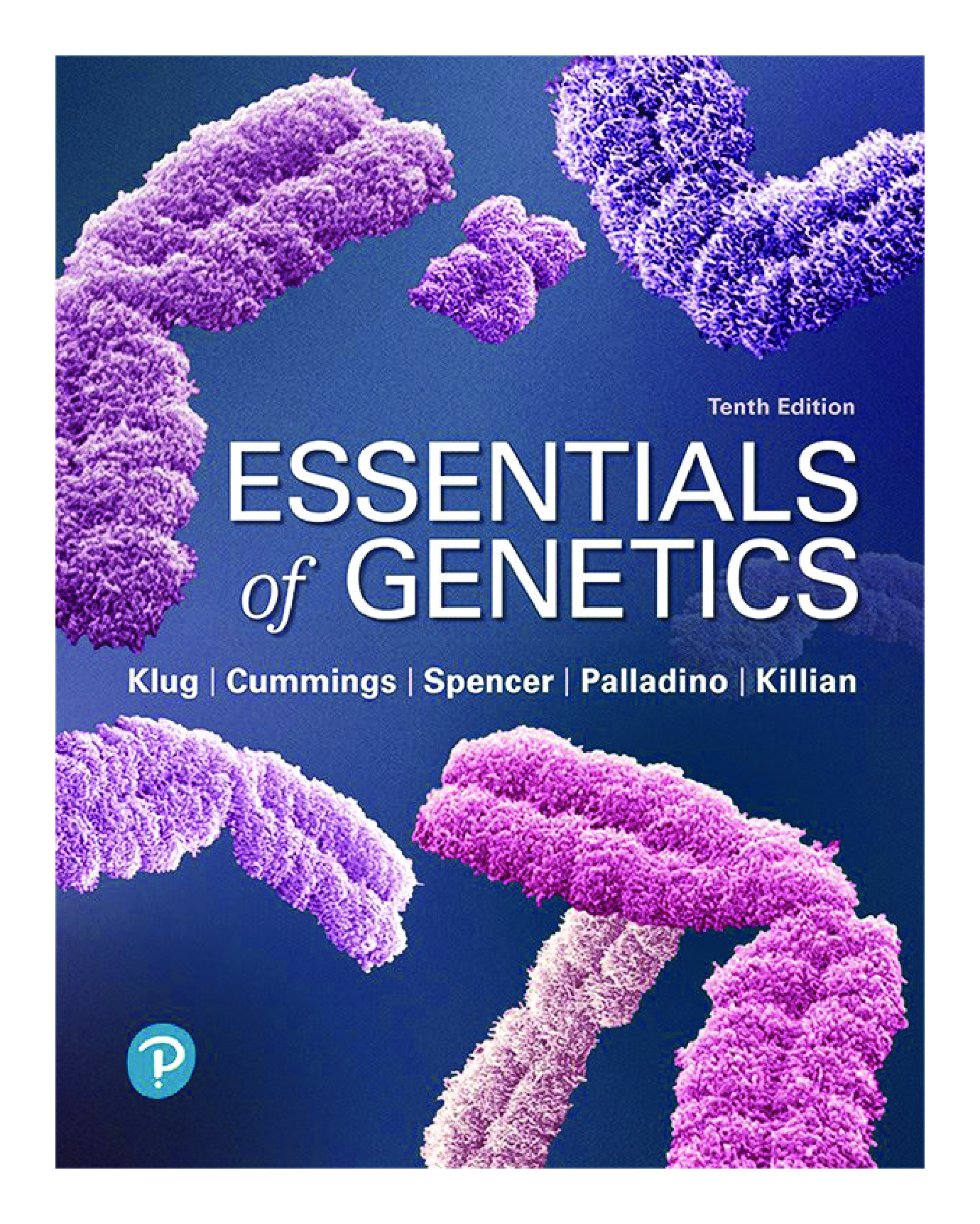
Reviews( 0 )
Document information
Connected school, study & course
About the document
Uploaded On
Dec 23, 2022
Number of pages
600
Written in
Additional information
This document has been written for:
Uploaded
Dec 23, 2022
Downloads
0
Views
47




